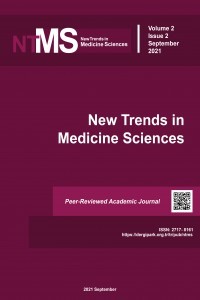The Effect of Coronavirus on the Liver and Histopathological Findings
The Effect of Coronavirus on the Liver and Histopathological Findings
Letter to the Editor Coronavirus is a single-stranded large RNA virus that infects humans (1). According to the World Health Organization (WHO), the cause of SARS - CoV - 2 is called disease COVID - 19. Similar to SARS - CoV, SARS - Cov - 2 mainly attacks the respiratory system. Symptomatic photographs indicate clinical symptoms of the disease, symptoms of fever, cough, fatigue and other respiratory infections (2). Although the main clinical findings of COVID - 19 are associated with lung injury, which is the main cause of mortality, findings related to the involvement of other organs such as cardiac and liver have also been reported (3). No evidence of isolated acute liver failure has been observed in COVID-19 patients, but there are articles on autopsy cases on histopathological data of liver damage during the disease. Zhang Y and colleagues from Wuhan University Zhongnan Hospital reported that they did not see a definite change in the macroscopic appearance of the liver in their autopsies from COVID-19 patients (1) In histopathological analysis, they stated that there was mild sinusoidal dilation and minimal lymphocytic infiltration and no other special damage was observed (1). Li Y et al. Also found that mild sinusoidal lymphocytic infiltration and sinusoidal dilatation were the main pathological findings in histopathological examination of the liver. Reported that they also observed mild steatosis and multifocal hepatic necrosis in some patients. In addition, they noted that hyperinflammatory reactions associated with COVID-19 and COVID-19 may contribute to liver damage in pre-existing chronic liver disease (4). In addition to other studies, Xu Z et al. Reported that portal inflammation was not prominent, they observed mild lobular and portal activity, moderate microvesicular steatosis (5). Tian S et al. Also observed hepatic necrosis foci in the liver zone 1 and zone 3 areas. They reported that they did not follow any serious inflammatory cell infiltration, cytoplasmic balloon degeneration, mallory hyaline or fibrosis. They emphasized that the current findings are consistent with the pattern of acute liver injury, and no more serious histological changes such as coagulative necrosis and severe cholestasis (6). Yao X, et al. Reported that they rarely observe canalicular cholestasis (7). Chai X et al. Stated that angiotensin converting enzyme 2 (ACE2), which is the default receptor for SARS ‐ CoV ‐ 2, is expressed more intensely in bile duct epithelial cells, but can be directly attached to these cells, but not to hepatocytes. For this reason, they thought that the liver abnormalities of the patients might be caused by cholangiocyte dysfunction, not hepatocyte damage (8). They emphasized that sinusoidal dilation was due to cardiogenic venous outflow slowing, however, other histological findings described were probably related to the patient's primary disease, namely COVID - 19. Drugs used in the treatment of COVID-1 9 (hydroxychloroquine and azithromycin) can also cause liver injury. These drugs have been shown to cause various degrees of hepatotoxicity. Also, the hypoxic condition commonly associated with COVID-19 pneumonia may make hepatocytes more susceptible to toxic injuries (6). Decreased perfusion to the liver due to heart failure in these patients may also exacerbate this process (4). These studies in the literature show that during the clinical course of COVID-19, cell injury due to direct viral origin and potential hepatotoxicity caused by therapeutic drugs occur. Especially in patients with serious or critical disease, liver damage has been observed to be significant. The underlying mechanisms of hepatic injury can be multifactorial and may vary individually. There are many factors related to this condition, including direct viral attack, hepatotoxicity of therapeutic drugs, hyper-inflammatory reactions, pre-existing chronic liver disease and hypoxemic state(4). As a result, in patients with COVID-19, mild increase in sinusoidal lymphocytic infiltration, sinusoidal dilation, mild steatosis and multifocal hepatic necrosis are the main histopathological abnormalities. Liver failure is not a prominent feature of the disease(9) Therefore, biopsy in this process is not recommended as it may cause greater harm than possible benefit.
___
- 1. Zhang Y, Zheng L, Liu L, Zhao M, Xiao J, Zhao Q. Liver impairment in COVID‐19 patients: A retrospective analysis of 115 cases from a single centre in Wuhan city, China. Liver International. 2020.
2. Chen N, Zhou M, Dong X, Qu J, Gong F, Han Y, et al. Epidemiological and clinical characteristics of 99 cases of 2019 novel coronavirus pneumonia in Wuhan, China: a descriptive study. The Lancet. 2020;395(10223):507-13.
3. Zhu N, Zhang D, Wang W, Li X, Yang B, Song J, et al. A novel coronavirus from patients with pneumonia in China, 2019. New England Journal of Medicine. 2020.
4. Li Y, Xiao SY. Hepatic involvement in COVID‐19 patients: pathology, pathogenesis and clinical implications. Journal of Medical Virology. 2020.
5. Xu Z, Shi L, Wang Y, Zhang J, Huang L, Zhang C, et al. Pathological findings of COVID-19 associated with acute respiratory distress syndrome. The Lancet respiratory medicine. 2020;8(4):420-2.
